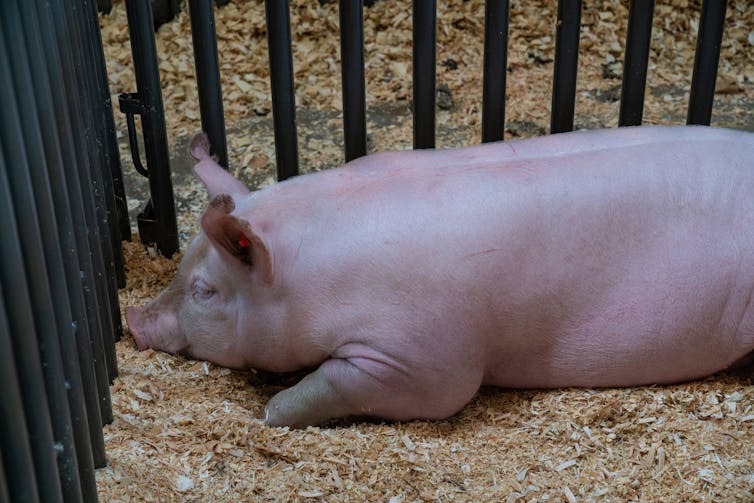Australians care about animals – but we don't buy ethical meat
- Written by Amelia Cornish, PhD student, University of Sydney
Australians clearly care about animal welfare: our research has found 92% shoppers in Sydney considered animal welfare to be important.
However, when we look at the distribution of market share of so-called high-welfare foods in Australia, we get a varied picture. Aussie shoppers seem to care far more about free-range eggs than the living conditions of pigs, cows and broilers (meat poultry).
Read more: What comes first: the free-range chicken or the free-range egg?
Free-range eggs now account for more than 40% of all eggs sold in Australia. This contrasts with only a 14% market share for free-range poultry and even less for pork, with only 5% coming from pigs raised outdoors.
Modern Australians are far removed from the production of their food. Around 95% of meat chickens and pigs eaten in Australia live on intensive farms, where huge numbers of animals are kept in small enclosed areas. This means we are largely divorced from the price animals pay in becoming our food.
Mind the hypocrisy gap
If we care about the welfare of the animals we eat, why don’t we buy foods that come from animals that were treated well? And why are we buying eggs that reflect higher welfare but not other animal-based foods?
This incongruence is an example of what is referred to as the attitude-behaviour gap, or the disparity between what we say and what we do. Many of us love animals, but buy the cheapest meat at the supermarket. This may be simply because all the different labels about welfare standards are too confusing, or it might be a consequence of the considerable price disparity.
Read more: How to know what you're getting when you buy free-range eggs
We also know when a researcher asks shoppers if they’d pay more for free-range, she may receive disingenuous answers. We often like the idea we’ll do the “right” thing, and until we’re forced to put our money where our mouth is, it costs nothing to say we would behave honourably.
Hard to know
Even with the best intentions, it can be hard to know how the cows and pigs we eat are raised. Australian legislation doesn’t require producers to disclose fully their farming methods, such as the use of sow stalls. Sow stalls are highly confined housing that pregnant pigs are kept in. Promisingly, Pork Australia has said Aussie farmers are voluntarily phasing them out.
Shoppers can easily be left in the dark about the animal welfare implications of certain foods or, worse, misled by an array of labels, claims or certifications that are essentially meaningless.
When it comes to pork and bacon, Aussie consumers are afforded no legally enforceable definitions for pig husbandry systems. Currently, upwards of 95% of all pigs grown in Australia have no outdoor access.
 It can be hard to find out how pigs are raised.
Tony Webster/Flickr, CC BY
It can be hard to find out how pigs are raised.
Tony Webster/Flickr, CC BY
When pigs are reared indoors, their stocking densities (number of animals per unit floor area) have a direct impact on farmers’ profit margins. Overcrowding and tail-biting in confined pigs are among the chief welfare concerns that drive consumers to pay a price premium for free-range pork and bacon.
But there is a growing trend towards use of the rather opaque term “outdoor-bred”. This denotes that piglets are born outdoors, but when weaned, at about 21 days of age, they are transferred to sheds where they spend the rest of their lives. Unfortunately, most consumers are unaware of the true conditions behind this label and think it indicates that the animals spend all of their lives ranging freely.
Bred free-range is such a misleading term that Australia’s consumer watchdog has pushed for the inclusion of the words “Raised indoors on straw” to make it clearer to consumers that the pigs are born outdoors but raised indoors from weaning until slaughter.
The stocking densities on Australian farms are governed by the Model Code of Practice for the Welfare of Animals: Pigs. However, for outdoor pigs, the code only offers “recommended” maximum stocking densities. Thus there is really no way of knowing how much space “free-range” pigs occupy, unless you study the details of accreditation or assurance schemes.
Information feeds demand
Australian shoppers now see plenty of information on egg cartons, which raises our awareness and, in turn, the demand for higher welfare eggs. This high demand lowers the price, and the attitude-behaviour gap shrinks a little when it comes to eggs.
Free-range eggs sell at a lower price premium than other high welfare animal-based foods. For example, intensively farmed cage eggs will cost you about A$3.50 per dozen, yet for just an extra dollar or two you can buy free-range eggs. This contrasts sharply with intensively farmed chicken meat, which will generally cost you A$7 per kg for breast fillets, while the free-range counterpart sits at around A$16/kg.
If you are confused about this disparity, so are we! That’s why we are exploring the extent of the attitude-behaviour gap in Australia and have launched an online survey. We need you to tell us how labelling around animal welfare influences your shopping decisions.
Read more: Animal welfare and animal rights are very different beasts
Welfare-friendly shopping involves avoiding foods that have been produced using practices such as so-called battery cages (for egg production) and sow stalls (for pork production). With the attitude-behaviour gap in mind, it’s important to find higher-welfare products by looking for labels such as RSPCA Approved Farming Scheme,Humane Choice or FREPA, just to name a few. But we should also be demanding clearer labels.
Authors: Amelia Cornish, PhD student, University of Sydney
Read more http://theconversation.com/australians-care-about-animals-but-we-dont-buy-ethical-meat-104394



